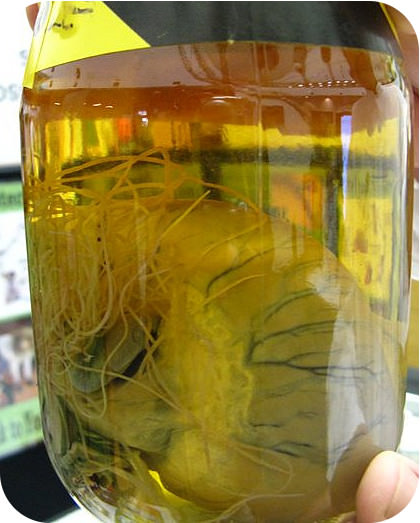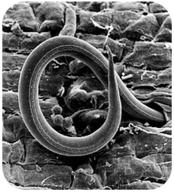9.6: Roundworms
- Page ID
- 2948

What is heartworm?
You may have heard that you need to protect your pets from heartworm. Heartworms are a type of roundworm. They can be parasites in cats and dogs. That means, once they infect your pet, they can cause harm. However, there are preventative treatments available.
Roundworms
The word "worm" is not very scientific. This informal term describes animals (usually invertebrates) that have long bodies with no arms or legs. Worms with round, non-segmented bodies are known as nematodes or roundworms (Figure below). They are classified in the phylum Nematoda, which has over 28,000 known species. Some scientists believe there could be over a million species of Nematodes.
Nematodes are slender bilaterally symmetrical worms, typically less than 2.5 mm long. The smallest nematodes are microscopic, while free-living species can reach as much as 5 cm, and some parasitic species are larger still, reaching over a meter in length. The worm body is often covered with ridges, rings, bristles, or other distinctive structures. The radially symmetrical head of a nematode also has distinct features. The head is covered with sensory bristles and, in many cases, solid "head-shields" around the mouth region. The mouth has either three or six lips arranged around the mouth opening, which often have a series of teeth on their inner edges.

Features of Roundworms
- Unlike the flatworms, the roundworms have a body cavity with internal organs.
- A roundworm has a complete digestive system, which includes both a mouth and an anus. This is a significant difference from the incomplete digestive system of flatworms. The roundworm digestive system also include a large digestive organ known as the gut. Digestive enzymes that start to break down food are produced here. There is no stomach, but there is an intestine which produces enzymes that help absorb nutrients. The last portion of the intestine forms a rectum, which expels waste through the anus.
- Roundworms also have a simple nervous system with a primitive brain. There are four nerves that run the length of the body and are connected from the top to the bottom of the body. At the anterior end of the animal (the head region), the nerves branch from a circular ring which serves as the brain. The head of a nematode has a few tiny sense organs, including chemoreceptors, which sense chemicals. Though still a relatively simple structure, the nervous system of roundworms is very different from that of the cnidarian nerve net.
Roundworms in the Environment
Roundworms can be free-living organisms, but they are probably best known for their role as significant plant and animal parasites. Most Nematodes are parasitic, with over 16,000 parasitic species described. Heartworms, which cause serious disease in dogs while living in the heart and blood vessels, are a type of roundworm. Roundworms can also cause disease in humans. Elephantiasis, a disease characterized by the extreme swelling of the limbs (Figure below), is caused by infection with a type of roundworm.

Most parasitic roundworm eggs or larvae are found in the soil and enter the human body when a person picks them up on the hands and then transfers them to the mouth. The eggs or larvae also can enter the human body directly through the skin. The best solution to these diseases is to try to prevent these diseases rather than treat or cure them.
Diseases caused by roundworms are more common in developing countries. Many parasitic diseases caused by roundworms result from poor personal hygiene. Contributing factors may include
- lack of a clean water supply,
- inadequate sanitation measures,
- crowded living conditions, combined with a lack of access to health care and low levels of education.
Summary
- Roundworms have a body cavity with internal organs and a simple nervous system.
- Roundworms can be free-living or parasitic.
Explore More
Use the resources below to answer the questions that follow.
Explore More I
- Nematode Movement at http://www.youtube.com/watch?v=SpgjnXEFadg (1:52)
- How does the movement of a nematode differ from the movement of an earthworm?
- Why can't a nematode move like an earthworm?
- What is the purpose of the nematode's cuticle?
Review
- What is a roundworm?
- How are the internal structures of the roundworms different from flatworms?
- What is the main cause of many parasitic diseases caused by roundworms?

